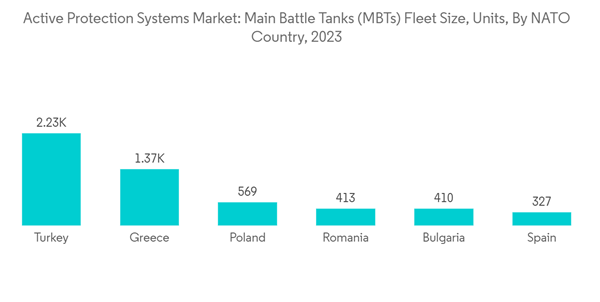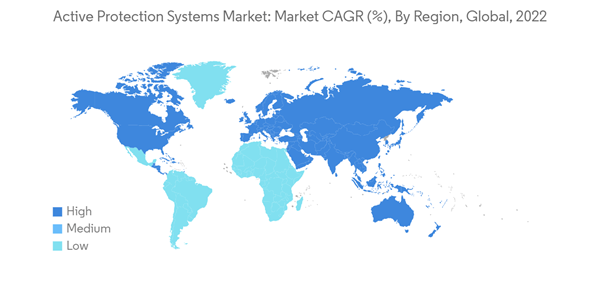The Active Protection Systems Market size is estimated at USD 4.23 billion in 2024, and is expected to reach USD 5.67 billion by 2029, growing at a CAGR of 6.06% during the forecast period (2024-2029).
Growing instances of asymmetric warfare and the emphasis on developing advanced warfare systems are the main drivers of the market. The emphasis on increasing the autonomy of the weapon systems has given rise to unmanned weapon technologies such as RWS and CIWS that can effectively neutralize a target without human intervention. The new variants of APS feature advanced optronic that renders them exceptionally suitable for urban warfare and thus reduce the casualties during a war.
The increasing sophistication of missile systems and other anti-tank threats has heightened the demand for active protection systems. These technologies offer a proactive defense layer, countering emerging threats and significantly increasing the survivability of military platforms. Ongoing advancements in sensor technologies, artificial intelligence, and rapid response mechanisms have propelled the evolution of APS. Enhanced sensors enable quicker threat detection, while AI-driven algorithms optimize response times, making these systems highly effective in dynamic and complex combat scenarios.
During the last decade, many countries have developed and fielded their autonomous weapon systems to bolster their military capabilities and to strengthen their troops in several conflicts around the world. The proliferation of innovations in the field of sensor technologies, weapon firing systems, and other auxiliary systems are aimed at enhancing the accuracy and performance capabilities of the current generation of active protection systems. Technological advancements remain a driving force across all segments of the APS market. Continuous innovation in sensor technologies, artificial intelligence algorithms, and response mechanisms enhances the overall effectiveness of APS solutions.
However, the market is marred by frequent installation and operational challenges associated with autonomous weapon systems, such as the inherent vulnerability to magnetic fields, radio signals, and other electronic attacks. The design and operational issues regarding the use of automated weaponry such as remote weapon stations (RWS) and CIWS may challenge the industry in the short term.
As militaries globally prioritize the protection of ground forces, the terrestrial platform segment is poised to maintain its dominant market share. For instance, in September 2022, Kongsberg Defence & Aerospace (KDA) established a strategic partnership with Hyundai Rotem to develop unmanned turrets and drone protection systems to be installed in next-generation tanks and wheel-type armored vehicles. Kongsberg products such as digital integrated systems would be installed on Hyundai Rotem's K2 tanks and K808 wheeled armored personnel carriers. Similarly, in January 2023, The US Army completed rigorous testing on an active protection system that showed significantly improved results. The Iron Fist light decoupled active protection system achieved further improved performance in recent live-fire testing on the Bradley Infantry Fighting Vehicle. The Iron Fist system consists of radar, optical sensors, and lightweight explosive projectile interceptors that can counter-launch incoming airborne threats. Such developments will boost the market growth in coming years.
Furthermore, the focus on enhancing product performance, reliability, and cost-effectiveness remains crucial in shaping competitive dynamics. For instance, in September 2022, Rafael Advanced Defense Systems Ltd. completed the acquisition of Pearson Engineering Ltd. (UK). The acquisition includes Pearson’s metalworks subsidiary company Responsive Engineering Ltd. Pearson and Responsive manufacture tank turret structure and is supported by Rafael for the UK MOD Challenger 3 program. Post acquisition, Pearson would be able to locally manufacture and integrate the TROPHY active protection system, providing the highest level of protection to the crew.
This product will be delivered within 2 business days.
Growing instances of asymmetric warfare and the emphasis on developing advanced warfare systems are the main drivers of the market. The emphasis on increasing the autonomy of the weapon systems has given rise to unmanned weapon technologies such as RWS and CIWS that can effectively neutralize a target without human intervention. The new variants of APS feature advanced optronic that renders them exceptionally suitable for urban warfare and thus reduce the casualties during a war.
The increasing sophistication of missile systems and other anti-tank threats has heightened the demand for active protection systems. These technologies offer a proactive defense layer, countering emerging threats and significantly increasing the survivability of military platforms. Ongoing advancements in sensor technologies, artificial intelligence, and rapid response mechanisms have propelled the evolution of APS. Enhanced sensors enable quicker threat detection, while AI-driven algorithms optimize response times, making these systems highly effective in dynamic and complex combat scenarios.
During the last decade, many countries have developed and fielded their autonomous weapon systems to bolster their military capabilities and to strengthen their troops in several conflicts around the world. The proliferation of innovations in the field of sensor technologies, weapon firing systems, and other auxiliary systems are aimed at enhancing the accuracy and performance capabilities of the current generation of active protection systems. Technological advancements remain a driving force across all segments of the APS market. Continuous innovation in sensor technologies, artificial intelligence algorithms, and response mechanisms enhances the overall effectiveness of APS solutions.
However, the market is marred by frequent installation and operational challenges associated with autonomous weapon systems, such as the inherent vulnerability to magnetic fields, radio signals, and other electronic attacks. The design and operational issues regarding the use of automated weaponry such as remote weapon stations (RWS) and CIWS may challenge the industry in the short term.
Active Protection Systems Market Trends
The Terrestrial Segment Holds Highest Shares in the Market
The terrestrial segment market holds the highest shares in the market. The growth is attributed to the extensive use of APS on ground-based military vehicles, including main battle tanks and armored personnel carriers. Main battle tanks, armored personnel carriers, and other terrestrial platforms benefit significantly from the deployment of APS, enhancing their survivability in hostile environments. The increasing prevalence of asymmetric threats and the need for rapid response capabilities contribute to the growing adoption of APS on terrestrial platforms. Ongoing technological advancements, such as modular and scalable APS solutions, further fuel the expansion of this segment.As militaries globally prioritize the protection of ground forces, the terrestrial platform segment is poised to maintain its dominant market share. For instance, in September 2022, Kongsberg Defence & Aerospace (KDA) established a strategic partnership with Hyundai Rotem to develop unmanned turrets and drone protection systems to be installed in next-generation tanks and wheel-type armored vehicles. Kongsberg products such as digital integrated systems would be installed on Hyundai Rotem's K2 tanks and K808 wheeled armored personnel carriers. Similarly, in January 2023, The US Army completed rigorous testing on an active protection system that showed significantly improved results. The Iron Fist light decoupled active protection system achieved further improved performance in recent live-fire testing on the Bradley Infantry Fighting Vehicle. The Iron Fist system consists of radar, optical sensors, and lightweight explosive projectile interceptors that can counter-launch incoming airborne threats. Such developments will boost the market growth in coming years.
North America to Dominate the Market During the Forecast Period
The United States and Canada are avid users of APS in North America. They are currently focusing on upgrading their existing vehicle fleet and corresponding capabilities. The region's leadership is attributed to factors such as heightened geopolitical tensions, substantial defence budgets, and a relentless focus on modernizing defence capabilities. The US, with its significant investments in advanced military technologies, plays a pivotal role in driving the demand for APS. The emphasis on enhancing the defensive capabilities of military assets, coupled with the continuous development of cutting-edge APS technologies, positions North America as a thriving market. Additionally, collaborations between government agencies and defence contractors further propel the growth of APS in the region. For instance, in February 2021, Lockheed Martin will supply up to 20 Modular Active Protection System (MAPS) base kits to US Army combat vehicles under a contract totalling up to USD 30 million. The kit includes a processor which integrates sensors and countermeasures in an open, common framework to detect, track, classify and defeat existing and emerging threats like rocket-propelled grenades and anti-tank guided missiles. Also, in July 2022, the US Army Contracting Command ordered additional TROPHY Active Protection Systems from General Dynamics Land Systems for the M1 ABRAMS Main Battle Tanks (MBTs), for about USD 280 million. TROPHY is developed by Rafael and is marketed in the US in cooperation with Leonardo DRS. Similar procurement and upgrade programs are anticipated to dirve the market growth across the region.Active Protection Systems Industry Overview
The active protection systems market is consolidated in nature due to presence of few players holding significant shares in the market. Some of the key players in the market are RTX Corporation, Leonardo S.p.A., BAE Systems plc, Rheinmetall AG, and Rafael Advanced Defense Systems Ltd. The growing demand for APS is fostering R&D for new optronics and sensor subsystems. Meanwhile, companies are trying to expand their geographical presence in emerging markets such as Asia-Pacific. Collaborations, strategic partnerships, and continuous innovation are key strategies employed by market players to maintain and expand their market share.Furthermore, the focus on enhancing product performance, reliability, and cost-effectiveness remains crucial in shaping competitive dynamics. For instance, in September 2022, Rafael Advanced Defense Systems Ltd. completed the acquisition of Pearson Engineering Ltd. (UK). The acquisition includes Pearson’s metalworks subsidiary company Responsive Engineering Ltd. Pearson and Responsive manufacture tank turret structure and is supported by Rafael for the UK MOD Challenger 3 program. Post acquisition, Pearson would be able to locally manufacture and integrate the TROPHY active protection system, providing the highest level of protection to the crew.
Additional Benefits:
- The market estimate (ME) sheet in Excel format
- 3 months of analyst support
This product will be delivered within 2 business days.
Table of Contents
1 INTRODUCTION
4 MARKET DYNAMICS
5 MARKET SEGMENTATION
6 COMPETITIVE LANDSCAPE
Methodology

LOADING...










